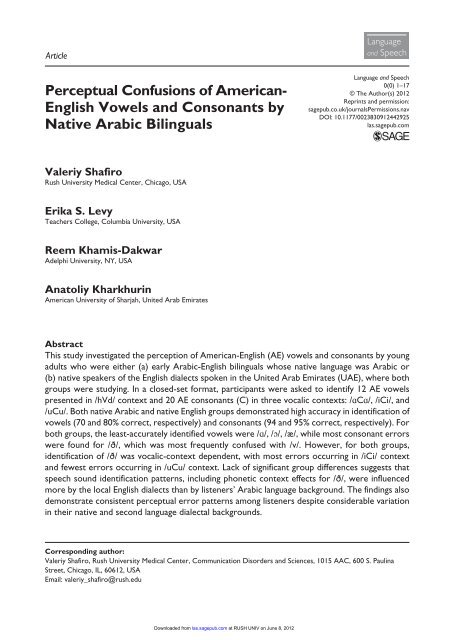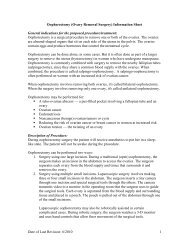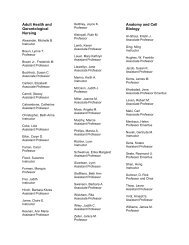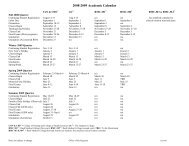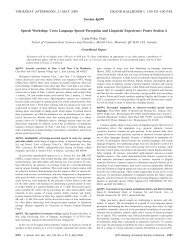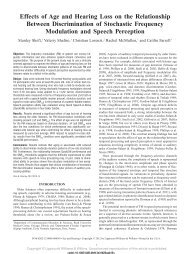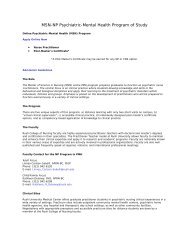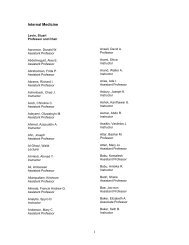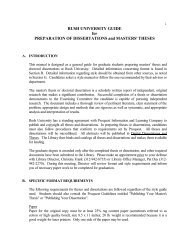English Vowels and Consonants by Native Arabic ... - Rush University
English Vowels and Consonants by Native Arabic ... - Rush University
English Vowels and Consonants by Native Arabic ... - Rush University
You also want an ePaper? Increase the reach of your titles
YUMPU automatically turns print PDFs into web optimized ePapers that Google loves.
442925LAS0010.1177/0023830912442925Shafiro et al.Language <strong>and</strong> Speech2012ArticleLanguage<strong>and</strong> SpeechPerceptual Confusions of American-<strong>English</strong> <strong>Vowels</strong> <strong>and</strong> <strong>Consonants</strong> <strong>by</strong><strong>Native</strong> <strong>Arabic</strong> BilingualsLanguage <strong>and</strong> Speech0(0) 1 –17© The Author(s) 2012Reprints <strong>and</strong> permission:sagepub.co.uk/journalsPermissions.navDOI: 10.1177/0023830912442925las.sagepub.comValeriy Shafiro<strong>Rush</strong> <strong>University</strong> Medical Center, Chicago, USAErika S. LevyTeachers College, Columbia <strong>University</strong>, USAReem Khamis-DakwarAdelphi <strong>University</strong>, NY, USAAnatoliy KharkhurinAmerican <strong>University</strong> of Sharjah, United Arab EmiratesAbstractThis study investigated the perception of American-<strong>English</strong> (AE) vowels <strong>and</strong> consonants <strong>by</strong> youngadults who were either (a) early <strong>Arabic</strong>-<strong>English</strong> bilinguals whose native language was <strong>Arabic</strong> or(b) native speakers of the <strong>English</strong> dialects spoken in the United Arab Emirates (UAE), where bothgroups were studying. In a closed-set format, participants were asked to identify 12 AE vowelspresented in /hVd/ context <strong>and</strong> 20 AE consonants (C) in three vocalic contexts: /ɑCɑ/, /iCi/, <strong>and</strong>/uCu/. Both native <strong>Arabic</strong> <strong>and</strong> native <strong>English</strong> groups demonstrated high accuracy in identification ofvowels (70 <strong>and</strong> 80% correct, respectively) <strong>and</strong> consonants (94 <strong>and</strong> 95% correct, respectively). Forboth groups, the least-accurately identified vowels were /ɑ/, /ɔ/, /æ/, while most consonant errorswere found for /ð/, which was most frequently confused with /v/. However, for both groups,identification of /ð/ was vocalic-context dependent, with most errors occurring in /iCi/ context<strong>and</strong> fewest errors occurring in /uCu/ context. Lack of significant group differences suggests thatspeech sound identification patterns, including phonetic context effects for /ð/, were influencedmore <strong>by</strong> the local <strong>English</strong> dialects than <strong>by</strong> listeners’ <strong>Arabic</strong> language background. The findings alsodemonstrate consistent perceptual error patterns among listeners despite considerable variationin their native <strong>and</strong> second language dialectal backgrounds.Corresponding author:Valeriy Shafiro, <strong>Rush</strong> <strong>University</strong> Medical Center, Communication Disorders <strong>and</strong> Sciences, 1015 AAC, 600 S. PaulinaStreet, Chicago, IL, 60612, USAEmail: valeriy_shafiro@rush.eduDownloaded from las.sagepub.com at RUSH UNIV on June 8, 2012
2 Language <strong>and</strong> Speech 0(0)KeywordsAmerican-<strong>English</strong>, <strong>Arabic</strong>, cross-dialect, cross-language, speech perception1 IntroductionAs a result of globalization, <strong>English</strong> often serves as a lingua franca in educational, medical <strong>and</strong>business settings worldwide (Kamwangamalu, 2003), with the number of nonnative <strong>English</strong> speakersaround the world beginning to outnumber native <strong>English</strong> speakers (Jenkins, 2000). In communitiesin which <strong>English</strong> is spoken, successful communication is critically dependent on the <strong>English</strong>comprehension abilities of individuals engaged in social interactions. Yet, even for proficient nonnative<strong>English</strong> speakers, speech intelligibility <strong>and</strong> language comprehension may be affected <strong>by</strong> avariety of factors, including the ability to accurately perceive the speech sounds of a language (seeRubin, 1994) <strong>and</strong> of different dialects of the same language (Clopper & Bradlow, 2008). This studyexamined the accuracy with which native speakers of <strong>Arabic</strong> living in the United Arab Emirates(UAE), where <strong>English</strong> is the lingua franca, identified American-<strong>English</strong> (AE) vowels <strong>and</strong>consonants.Along with several countries in the Middle East, the UAE has made a concerted effort to institutewidespread <strong>English</strong> language literacy among its residents (Khalaf, 2009; Lewis, 2008). Presently,<strong>English</strong> is the primary language for a considerable portion of official <strong>and</strong> informal communicationin the UAE, where a large variety of <strong>English</strong> dialects are spoken, most commonly those of SouthAsian origin (Leonard, 2005). American <strong>English</strong> dialects are frequently used in educational,governmental, <strong>and</strong> business settings (Clarck, 2006). The presence of AE, <strong>and</strong> the accompanyingneed to underst<strong>and</strong> it, is expected to grow in the UAE <strong>and</strong> other Middle Eastern countries in thenear future as increasing numbers of American universities open satellite campuses in the PersianGulf region <strong>and</strong> there are increasing interactions with United States government <strong>and</strong> businesses(Rupp, 2009; US–Middle East Partnership Initiative http://mepi.state.gov). However, little ispresently known about the ability of native <strong>and</strong> nonnative <strong>English</strong> speakers in the region to perceivethe speech sounds of AE. Three major language-related factors may be expected to play a role inthe perception of AE speech sounds in the UAE <strong>and</strong> neighboring countries: (1) the influence of thelisteners’ native language, (2) the influence of the <strong>English</strong> dialect(s) in which <strong>English</strong> learning <strong>and</strong>daily communications occur in the region, <strong>and</strong> (3) the influence of the phonetic context in whichindividual speech sounds are presented. These factors <strong>and</strong> their potential effects on the perceptualconfusions of AE speech sounds are considered separately below.1.1 <strong>Native</strong> language effectsFirst, the native language of the majority of individuals in the region is <strong>Arabic</strong>. Thus, native <strong>Arabic</strong>phonology may influence their perception of nonnative <strong>English</strong> speech sounds in systematic ways,related to the relative composition of the <strong>Arabic</strong> <strong>and</strong> <strong>English</strong> phonological inventories. The effectsof <strong>Arabic</strong> as a native language on the perception of AE speech sounds may be influenced <strong>by</strong> a widevariety of <strong>Arabic</strong> dialects spoken in the region. <strong>Arabic</strong>-speaking UAE residents are native speakersof <strong>Arabic</strong> dialects specific to their region of origin, but are also typically educated in Modern St<strong>and</strong>ard<strong>Arabic</strong> (MSA) – a phenomenon known as diglossia (Ferguson, 1959). According to Ferguson,<strong>Arabic</strong> diglossia is characterized <strong>by</strong> the existence of the “low” <strong>and</strong> “high” language varieties of<strong>Arabic</strong>. The low language variety refers to the spoken dialects used for daily communication. Thehigh language variety refers to MSA or Classical <strong>Arabic</strong>, which is used mainly in written texts <strong>and</strong>formal settings <strong>and</strong> unifies the <strong>Arabic</strong>-speaking world (Ferguson, 1959; Holes, 2004). LinguisticDownloaded from las.sagepub.com at RUSH UNIV on June 8, 2012
Shafiro et al. 3differences between the colloquial varieties <strong>and</strong> MSA are manifested in all language domains(Abu-Rabia, Share, & Mansour, 2003; Ibrahim, 1983; Khamis-Dakwar, Froud, & Gordon, 2012;Rosenhouse, 1997). However, the separateness of these two linguistic systems is still debated in theliterature (Hary, 1996; Khamis-Dakwar & Froud, 2007).At the most general level, the phonological inventory of the high <strong>Arabic</strong> language variety, MSA,which is generically less variable among speakers of different dialects of <strong>Arabic</strong>, includes 28consonants <strong>and</strong> six vowels. The vowels are characterized as three short <strong>and</strong> three long vowels (/i/,/i:/, /a/, /a:/, /u/, /u:/), with vowel duration being phonemically distinctive (Holes, 2004). On theother h<strong>and</strong>, the phonological inventories of the low language varieties are highly variable among<strong>Arabic</strong> speakers. Different dialects have a different number <strong>and</strong> quality of vowels <strong>and</strong> consonants.For instance, while Kuwaiti <strong>Arabic</strong> has an eight-vowel system (/i/, /i:/, /a/, /a:/, /u/, /u:/, /e:/, <strong>and</strong>/o:/), Syrian <strong>Arabic</strong> has an eleven-vowel system (/i/, /i:/, /e/, /e:/, /a/, /a:/, /u/, /u:/, /o/, /o:/, <strong>and</strong> /ə/)(Cowell, 1964). Even though all versions of colloquial <strong>Arabic</strong>’s phonological system differ fromthat of MSA (Ibrahim, 1986), Ferguson (1959) maintains that the sound systems of MSA <strong>and</strong>colloquial <strong>Arabic</strong> varieties constitute a single phonological system of which the colloquialphonology is the basic system <strong>and</strong> the divergent features of MSA phonology are a subsystem orparasystem. Because the two systems together have a smaller vowel inventory than the AE vowelinventory, which contains 12 stressed vowels (including /ɝ/), it may be expected that more than oneAE vowel may be assimilated to a single <strong>Arabic</strong> vowel category (Best, 1995).<strong>Consonants</strong> in all <strong>Arabic</strong> phonological inventories are marked <strong>by</strong> the presence of emphatic <strong>and</strong>pharyngeal consonants. Emphatic phones, such as /ṭ/, /ḍ/, /ð. /, /ẓ/, <strong>and</strong> /ṣ/, are coronal obstruentscharacterized <strong>by</strong> a secondary articulation involving retraction of the tongue, resulting in a narrowingin the upper portion of the pharynx, along with their primary coronal articulation (Ghazali,1977). Acoustic correlates of emphatic phones include a raised third formant, a lowered secondformant, <strong>and</strong> a raised first formant suggesting a pattern of narrowing near the epiglottis (Jongman,Herd, & Al-Masri, 2007). Two pharyngeal consonants exist in <strong>Arabic</strong>: the voiceless /ħ/ <strong>and</strong> voiced/ς/ <strong>and</strong> three uvular (/x/, /γ/, <strong>and</strong> /q/) consonants. /ħ/ <strong>and</strong> /ς/ involve a low pharyngeal constriction<strong>and</strong> are described as approximants. /ς/ has vowel-like formant structures. On the other h<strong>and</strong>,emphatic <strong>and</strong> pharyngeal consonants are not found in <strong>English</strong>. It is also worth noting that the following<strong>English</strong> consonants are not found in <strong>Arabic</strong>: /p/, /v/, /ɹ/, /ʒ/, /g/, /ð/, <strong>and</strong> /ŋ/ (Amayreh &Dyson, 1998) <strong>and</strong>, thus, may not be easily mapped onto <strong>Arabic</strong> consonant counterparts.1.2 Effects of regional <strong>English</strong> dialectsA second factor that may affect the perception of AE speech sounds in the Gulf region <strong>by</strong> L2<strong>English</strong> speakers whose native language is <strong>Arabic</strong> involves the variety of <strong>English</strong> dialects thatconstitute the learning <strong>and</strong> communication environment. As previously mentioned, the majority oflocally-spoken <strong>English</strong> dialects are primarily of South Asian origin (e.g., Pakistan, India, SriLanka, Bangladesh, Philippines), often spoken <strong>by</strong> nonnative <strong>English</strong> speakers, with highly diversenative language backgrounds. Thus, the phonological characteristics of locally-spoken <strong>English</strong>dialects that are commonly used in education, business, <strong>and</strong> social settings may also affect theperception of AE speech sounds, even among early bilinguals or native <strong>English</strong> speakers inthe UAE. Previous studies indicate that <strong>English</strong> dialects can differ in their overall intelligibilityfor the same listener group <strong>and</strong> that perception of speech in an unfamiliar dialect or with anunfamiliar foreign accent may decrease intelligibility (Bradlow & Bent, 2003, 2008; Clarke, 2003;Clopper & Bradlow, 2008). Hypotheses regarding the possible perceptual consequences as afunction of the many <strong>English</strong> dialects spoken <strong>by</strong> the listeners in the UAE would be beyond theDownloaded from las.sagepub.com at RUSH UNIV on June 8, 2012
4 Language <strong>and</strong> Speech 0(0)scope of this paper <strong>and</strong> require a great deal of preliminary research. However, as many of the<strong>English</strong> dialects stemming from East Asia are more similar to St<strong>and</strong>ard British <strong>English</strong> (i.e.,Received Pronunciation) than St<strong>and</strong>ard American <strong>English</strong>, it may be expected that listeners in theUAE may be more familiar with this dialect, as well as other characteristics of their particular <strong>English</strong>dialect. Thus, for example, perception of AE <strong>by</strong> individuals whose <strong>English</strong> is of Philippine origin maybe affected <strong>by</strong> British <strong>English</strong> vowel mergers, as well as <strong>by</strong> bilabial stop vs. labiodental fricativeconfusions that result from the absence of labiodental fricatives in Tagalog (Espinosa, 1997).1.3 Phonetic context effectsThird, speech sound identification can be influenced <strong>by</strong> the phonetic context. Significant consonantal-contexteffects have been documented in cross-language vowel perception <strong>and</strong> production(Gottfried, 1984; Levy, 2009a, 2009b; Levy & Law, 2010; Levy & Strange, 2008). There is alsosome evidence of vocalic context effects on consonants in native listeners with typical speech communication(Monnin, Loevenbruck, Beckman, & Edwards, 2011; Yeon, Wayl<strong>and</strong>, Harnsberger, &Silver, 2004) <strong>and</strong> <strong>by</strong> listeners with hearing impairments who use cochlear implants (Donaldson &Kreft, 2006). Effects of vocalic context on consonant identification have been also shown in atleast one study for identification of nonnative <strong>Arabic</strong> consonants <strong>by</strong> Korean-<strong>Arabic</strong> bilingualswhose native language was Korean (Hong & Sarmah, 2009).1.4 The present studyThe main purpose of the present study was to provide an initial assessment of the abilities of<strong>English</strong> speakers from a linguistically-diverse Middle Eastern country to identify AE vowels <strong>and</strong>consonants. Because no previous research has addressed this question for <strong>English</strong> speakers in theGulf region, this study took an exploratory approach that would provide general perceptualcharacteristics of a representative sample of young adult <strong>English</strong> speakers. Participants included(1) a group of early <strong>Arabic</strong>-<strong>English</strong> bilinguals <strong>and</strong> (2) a group of native <strong>English</strong> speakers of variousgeographic <strong>and</strong> linguistic origins, with all participants enrolled in a UAE university in which<strong>English</strong> is the primary language of instruction. Although the <strong>Arabic</strong> dialectal backgrounds of theparticipants in the first group, as well as the <strong>English</strong> dialectal backgrounds of the participants in thesecond group, were quite heterogeneous, as described below, these participants provided anecologically valid representative sample of young adult <strong>English</strong> speakers, characteristic of thatregion. For these students, the ability to communicate in <strong>English</strong>, in general, <strong>and</strong> to perceive thesounds of AE, in particular, is expected to be most relevant at the present time <strong>and</strong>, possibly, in thefuture. The specific objectives of the study were to (1) evaluate the overall identification accuracyof AE vowels <strong>and</strong> consonants in proficient young adult <strong>Arabic</strong>-<strong>English</strong> bilinguals living in theUAE; (2) assess relative perceptual difficulty <strong>and</strong> classification error patterns for specific vowels<strong>and</strong> consonants; (3) examine potential effects of different vocalic contexts on consonant perceptionin light of previous findings demonstrating phonetic context effects on the perception of secondlanguage speech sounds (Gottfried, 1984; Hong & Sarmah, 2009; Levy, 2009a, 2009b).It was expected that participants in both groups would demonstrate high overall accuracy in theidentification of AE speech sounds because of the high overall <strong>English</strong> language proficiencyrequired for college education. Owing to the exploratory nature of the study <strong>and</strong> little existinginformation about the phonology of local <strong>Arabic</strong> <strong>and</strong> <strong>English</strong> dialects, no strong predictions couldbe made about specific vowel <strong>and</strong> consonant error patterns or effects of phonetic contexts. However,“new” sounds (i.e., speech sounds with no phonetic counterpart in the native language) wereDownloaded from las.sagepub.com at RUSH UNIV on June 8, 2012
Shafiro et al. 5expected to be more accurately perceived <strong>and</strong> produced than “similar” sounds with L1 counterparts(Flege, 1995).Thus, the following hypotheses were cautiously offered. To a first approximation, it wasexpected that UAE <strong>Arabic</strong>-<strong>English</strong> bilinguals would experience greatest difficulties with the AEspeech sounds that have similar, but not identical, counterparts in their L1 phonological inventorythan those that do not have an obvious unique phonological counterpart (Flege, 1987, 1995). Thiswas expected to be true for the consonants /p/, /v/, /ɹ/, /ʒ/, /ð/, /g/, <strong>and</strong> /ŋ/, which comprise part ofthe AE, but not MSA or most of the <strong>Arabic</strong> phonological inventories. However, the magnitude ofnative language effects could be substantially mediated <strong>by</strong> the age of L2 learning (Best & Tyler,2007; Flege, 1995).Regarding vowels, given the generally smaller vowel inventory of MSA <strong>and</strong> regional <strong>Arabic</strong> dialectsin comparison to the AE vowel inventory, which contains 12 stressed vowels (including /ɝ/), itwas expected that more than one AE vowel would be assimilated to a single <strong>Arabic</strong> vowel category(Best, 1995). This mismatch would, therefore, result in poor identification of vowels such as /ɑ/, /ɔ/,/æ/, /ʌ/ with no identical <strong>Arabic</strong> counterpart. However, it was considered possible that these L2 vowelswould be perceived as “new” or “uncategorized” vowels <strong>and</strong> thus with greater accuracy, but lessstability, than vowels assimilated to native categories (Best & Tyler, 2007; Flege, 1995). As durationaldifferences are contrastive in the listeners’ native <strong>Arabic</strong> (<strong>and</strong> generally more acoustically salientcues than are spectral differences), native speakers of <strong>Arabic</strong> would likely rely on durational cues(rather than spectral cues) more than would native speakers of AE (Flege, Bohn, & Jang, 1997), thusdiscriminating vowels differently from, <strong>and</strong> probably less accurately than native listeners.Given the large degree of heterogeneity in participants’ native <strong>Arabic</strong> <strong>and</strong> local <strong>English</strong> dialectsthat might affect their perception of AE sounds, it was important to establish first whether stableerror patterns would be obtained across participants in either group. It was expected that stableidentification error patterns would be obtained for each group, given the early age of <strong>English</strong>acquisition for <strong>Arabic</strong>-native bilinguals <strong>and</strong> a long history of exposure to the same set of <strong>English</strong>dialects in the UAE for most participants. Cross-group comparisons could then further indicate theextent to which listener performance was driven <strong>by</strong> the participants’ native language versus local<strong>English</strong> dialect(s), thus providing a basis for future investigations. Similar error patterns betweennative <strong>Arabic</strong> <strong>and</strong> native <strong>English</strong> groups would indicate the dominant role of the local <strong>English</strong>dialect, while differences in identification error between the groups could suggest the effects ofnative language phonology.2 MethodVowel <strong>and</strong> consonant tests were administered to listeners to determine their overall <strong>and</strong> speechsound-specific identification accuracy. The consonant test required closed-set identification of 20AE consonants presented separately in three different vocalic contexts: /ɑCɑ/, /iCi/, /uCu/. Thevowel test required closed-set identification of 12 AE vowels presented in a fixed /hVd/ context.All participants were tested simultaneously in a quiet room equipped with personal computers, intwo separate sessions that lasted approximately 30 minutes each. Stimuli were presented overheadphones at a comfortable listening level.2.1 ParticipantsForty-two proficient <strong>English</strong> speakers enrolled in undergraduate studies at the American <strong>University</strong>of Sharjah, where <strong>English</strong> is the main language of instruction, participated. Their average age wasDownloaded from las.sagepub.com at RUSH UNIV on June 8, 2012
6 Language <strong>and</strong> Speech 0(0)20 years (range 17–24), <strong>and</strong> none of the participants reported history of speech or hearingimpairments. Twenty-five bilinguals (20 females, 5 males) comprised the native <strong>Arabic</strong> languagegroup (NA), <strong>and</strong> 17 (12 females, 5 males) comprised the native <strong>English</strong> language group (NE). Allparticipants received partial course credit for participation in an experiment.For the 25 bilinguals in the NA group, participants’ reported places of origin were UAE (5),Saudi Arabia (5), Oman (3), Lebanon (3), Egypt (3), Bahrain (2), Palestine (2), Syria (1), <strong>and</strong> Iraq(1). Their mean age of arrival to UAE was 11 years (range 0–20), <strong>and</strong> average duration of residencein the UAE was 10 years (2–20). All considered <strong>Arabic</strong> their native language. Their average age ofstarting to learn <strong>English</strong> (either at home, at school or both) was 3 years, range 0–7). Most subjectsconsidered themselves fully bilingual or more proficient in <strong>English</strong> than in <strong>Arabic</strong> <strong>and</strong> reportedapproximately equal use of <strong>Arabic</strong> <strong>and</strong> <strong>English</strong> in daily life. All participants also reported that theywere proficient in MSA.For the 17 participants in the NE group, reported places of origin included India (4), Pakistan(4), Sudan (2), Iran (1), Iraq (1), Malawi (1), Palestine (1), Pol<strong>and</strong> (1), Qatar (1), <strong>and</strong> UAE (1).Their mean age of arrival to UAE was nine years (range 0–20), <strong>and</strong> mean duration of residence inUAE was 11 years (range 1–22).All participants in the NE group also had proficiency in at least one additional language, which,for the majority was Urdu (6), followed <strong>by</strong> <strong>Arabic</strong> (4), with other languages being Hindi, Gujarati,Malayalam, Polish, Persian, Portuguese, French, <strong>and</strong> Japanese. Of the 17 participants, 10 had someproficiency in three of these languages, <strong>and</strong> six in four of these languages. 12.2 Stimuli <strong>and</strong> procedureThe vowel test was based on the materials developed <strong>by</strong> Hillenbr<strong>and</strong>, Getty, Clark, <strong>and</strong> Wheeler(1995), available from http://homepages.wmich.edu/~hillenbr/voweldata.html. They included 12AE vowels spoken in hVd contexts: heed (/i/), hid (/ɪ/), hayed (/e/), head (/ɛ/), had (/æ/), hod (/ɑ/),hawed (/ɔ/), hoed (/o/), hood (/ʊ/), who'd (/u/), hud (/ʌ/), heard (/ɝ/). Each vowel was spoken <strong>by</strong>five male <strong>and</strong> five female talkers for a total of 120 stimuli, ensuring interspeaker variability.Vowel productions were selected from talkers who demonstrated maximum accuracy overall <strong>and</strong>for specific vowel contrasts, such as the /ɑ-ɔ/ distinction found in only some AE dialects (Strangeet al., 2007).The consonant test was based on the materials developed <strong>and</strong> provided <strong>by</strong> Shannon, Jensvold,Padilla, Robert, <strong>and</strong> Wang (1999) <strong>and</strong> included 20 AE consonants (/p, t, k, f, ð, s, ʃ, tʃ, b,d, g, v, z, dʒ, r, l, w, j, m, n/), each spoken in three vocalic contexts: /ɑCɑ/, /iCi/, /uCu/. Eachconsonant was spoken <strong>by</strong> one male <strong>and</strong> two female talkers, totaling 60 stimuli. All stimuliwere presented twice in r<strong>and</strong>om order, resulting in 120 trials per vowel context or 360 totalconsonant trials.Vowel <strong>and</strong> consonant files, sampled at 32,000 Hz <strong>and</strong> 44,100 Hz, respectively, were normalizedin root-mean-square energy <strong>and</strong> presented to participants at a comfortable listening level usingpersonal computers with Praat software (Boersma & Weenink, 2007). Both tests were given in aclosed-set format <strong>and</strong> were self-paced. The consonant test was further blocked <strong>by</strong> vocalic context.In each trial, the participant heard a stimulus <strong>and</strong> selected one of the displayed response options.These were the 12 /hVd/ words with target vowels or 20 letter symbols, one for each consonant,following typical orthographic sound-to-letter conventions, for example, ‘k’ for /k/, ‘sh’ for /ʃ/ <strong>and</strong>so on. No feedback or additional familiarization was provided during the tests. During the firsttesting session, all participants completed the vowel test <strong>and</strong> the consonant test in one vocalicDownloaded from las.sagepub.com at RUSH UNIV on June 8, 2012
8 Language <strong>and</strong> Speech 0(0)Table 2. Vowel identification responses of the native <strong>English</strong> participants as percentages of the total foreach vowel category presented. Vowel stimuli are listed in the first column <strong>and</strong> vowel response labels arelisted in the top row.StimulusResponseheed hid hayed head had hod hawed hoed hood who’d hud heardheed (i) 92.4 5.3 0.6 1.2 0.6hid (ɪ) 0.6 98.2 1.2hayed (e) 5.3 94.1 0.6head (ɛ) 89.4 8.2 0.6 0.6 1.2had (æ) 0.6 25.9 73.5hod (ɑ) 0.6 40.6 15.9 17.6 0.6 20.6 4.1hawed (ɔ) 2.4 26.5 55.9 1.2 14.1hoed (o) 2.9 6.5 88.8 1.2 0.6hood (ʊ) 1.2 0.6 88.8 2.9 6.5who’d (u) 0.6 5.9 12.9 79.4 1.2hud (ʌ) 0.6 5.9 1.2 17.6 74.1 0.6heard (ɝ) 100.0often confused with /æ/, a low-mid front vowel than with /ʌ/, which is a more mid-central vowel,closer to /ɑ/ in acoustic <strong>and</strong> articulatory space. On the other h<strong>and</strong>, in both groups, high front vowelswere more identifiable <strong>and</strong> less confusable with other vowels despite similar acoustic distances(i.e., /e/, /ɪ/, /i/ – 93, 91, 89% correct, respectively, for the NA <strong>and</strong> 94, 98, 92% correct, respectively,for the NE).3.2 <strong>Consonants</strong>Overall consonant identification accuracy was high in both groups across vocalic contexts (i.e.,95% correct for NA <strong>and</strong> 94% correct for NE) <strong>and</strong> within each context (i.e., /ɑCɑ/, /iCi/, /uCu/ –97, 93, 95% correct, respectively, for NA <strong>and</strong> 95, 92, 94% correct, respectively, for NE). As alsofound for native AE listeners in the USA (Shannon et al., 1999), both the native <strong>Arabic</strong> <strong>and</strong> native<strong>English</strong> listeners in the UAE had the highest number of errors for /ð/, which was most often misidentifiedas /v/. For both the native <strong>Arabic</strong> <strong>and</strong> native <strong>English</strong> listeners in the UAE identificationof /ð/ was context dependent. While for both groups /ð/ identification was poor in /ɑCɑ/ <strong>and</strong> /iCi/contexts (i.e., 64 <strong>and</strong> 37% correct, respectively, for NA <strong>and</strong> 60 <strong>and</strong> 44% correct respectively, forNE), it was considerably more accurate in /uCu/ context (i.e., 96% <strong>and</strong> 86% for NA <strong>and</strong> NE,respectively). Between group t-tests with Bonferroni correction for /ð/ in each context confirmedthe absence of significant differences for /ð/. Nevertheless, the somewhat lower /ð/ accuracy ofthe participants in the NE group in the /uCu/ context may be related to a number of /z/ errorresponses (12%) to /ð/ in the NE group only. The /z/ response to /ð/ was completely absent in theNA group for this context (Tables 3 <strong>and</strong> 4).Additional minor but consistent confusions were found in both NA <strong>and</strong> NE groups for the consonant/r/, which was sometimes identified as /v/. Strikingly, the tendency to provide a /v/ responseto /r/ was only present in /uru/ context (i.e., 11% /v/ responses for NA <strong>and</strong> 20% /v/ responses forNE). The /r-v/ confusions may result from the coarticulatory lip rounding during the production of/uru/, which could obscure the acoustic differences between the two consonants.Downloaded from las.sagepub.com at RUSH UNIV on June 8, 2012
Shafiro et al. 11The overall similar performance of the native <strong>Arabic</strong> <strong>and</strong> the native <strong>English</strong> groups suggests thatvowel <strong>and</strong> consonant identification errors were influenced more <strong>by</strong> the regional <strong>English</strong> dialectthan native language phonology. Although there was a small, but significant, advantage in vowelidentification accuracy for the NE group, identification error patterns remained largely the same asfor the NA group, suggesting that the differences between the two groups were quantitative, notqualitative. The single exception was the /v-w/ distinction, which was more difficult for the NElisteners, suggesting a second language influence between the groups, as these responses werecommon for NE listeners whose second languages (e.g., Hindi, Urdu) did not have the /v-w/distinction present in AE (Masica, 1991; Ohala, 1999).4.2 Types of errorsThe second research question addressed the classification errors that would occur. The error patternsthat were still present for vowel <strong>and</strong> consonant identification were remarkably consistentbetween the two groups despite the substantial variability in participants’ native <strong>Arabic</strong> dialects<strong>and</strong> <strong>English</strong> dialectal backgrounds. Such consistency in responses suggests that participants’ perceptualclassification of AE vowels <strong>and</strong> consonants was largely driven <strong>by</strong> a similar set of factors.Also of interest for the NA group was the unexpected near absence of confusions between /p/ <strong>and</strong>/b/ despite the absence of /p/ in <strong>Arabic</strong>, a finding not consistent with /p-b/ confusions <strong>by</strong> native<strong>Arabic</strong> speakers reported in the literature <strong>and</strong> <strong>Arabic</strong> speakers’ nonnative-like productions of /p/,/t/, /k/ in <strong>English</strong> (Flege & Port, 1981). This finding may be attributable to the higher proficiencyor earlier acquisition of <strong>English</strong> in these participants than those in previous studies or to the moreaccurate production of “new” speech sounds than speech sounds that are perceived as similar tonative phonological categories (Flege, 1995). On the other h<strong>and</strong>, most of the consonant <strong>and</strong> vowelconfusions in our study suggest that speech sounds with no counterpart in the native language/dialect were relatively difficult to identify accurately. For example, the common finding of /ð-v/confusions <strong>and</strong> confusions involving /r/ may have been expected from native speakers of <strong>Arabic</strong>,as /ð/, /v/, <strong>and</strong> /ɹ/ are included in the <strong>Arabic</strong> phonological inventory. The prevalence of similarconfusions among native <strong>English</strong> speakers in both the UAE <strong>and</strong> the US, as described below, alsopoints to the influence of locally-spoken <strong>English</strong> dialects, primarily of South Asian origin.Generally, as expected, AE vowels with no counterpart in MSA, /ɑ/, /ɔ/, /æ/, accounted for themost vowel confusions in both groups. Listeners heard /ɑ/ in ‘hod’ most often as /æ/ in ‘had’ followedclosely <strong>by</strong> confusions with /ʌ/ in ‘hud’. For NA listeners, this may reflect the mapping of themore numerous mid <strong>and</strong> low phones of AE onto the single low /a/ category in <strong>Arabic</strong>. The reasonsfor this confusion are less clear in the NE listeners <strong>and</strong> might indicate a reduced vowel inventory oflocal <strong>English</strong> dialects compared to AE. In both groups, the /ɔ/ in ‘hawed’ was most often confusedwith /ɑ/ in ‘hod’. The /ɔ-ɑ/ distinction is one made only in parts of the United States, such as the NewYork regional area (Strange et al., 2007). Thus this distinction might not be produced or perceived<strong>by</strong> many native speakers of <strong>English</strong> <strong>and</strong> L2 learners raised both in <strong>and</strong> out of the United States. Thevowels in ‘head’ <strong>and</strong> ‘had’ were also confused frequently, findings similar to those reported <strong>by</strong> Bohn<strong>and</strong> Flege (1990) on /ɛ-æ/ confusions for German listeners. This confusion may reflect the phonologicalproximity of these vowels in AE <strong>and</strong> the lack of distinct <strong>Arabic</strong> counterparts. That is, <strong>English</strong>words with sparse phonological neighborhoods (i.e., smaller number of words that sound similar toeach other) are recognized more accurately <strong>and</strong> rapidly than words with dense neighborhoods (Luce& Pisoni, 1998). The neighborhood spread (i.e., the number of speech sounds that may be changedto create words) also influences word recognition (Vitevitch, 2007). Thus, in terms of overall speechcomprehension, it may be expected that vowel confusions associated with large numbers ofDownloaded from las.sagepub.com at RUSH UNIV on June 8, 2012
12 Language <strong>and</strong> Speech 0(0)minimal pair contrasts in <strong>English</strong> might impede overall comprehension (i.e., /ɛ-æ/, /ɑ-ʌ/, /ɑ-æ/),while less frequently occurring contrasts, such as /u-ʊ/ may be less crucial (Dewey, 1923).4.3 Vocalic context effectsIn response to the third research question investigating vocalic context effects, an unexpectedvocalic context effect was revealed in the present study: listeners produced /ð-v/ confusions in/ɑCɑ/ <strong>and</strong> /iCi/ context more often than in /uCu/ context. Monolinguals’ perception of their nativeAE consonants has shown vocalic context effects for listeners with normal hearing (e.g., Nittrouer& Stoddert-Kennedy, 1987; Whalen, 1981) <strong>and</strong> listeners with cochlear implants (Donaldson &Kreft, 2006). However, with few exceptions (Hong & Sarmah, 2009; Monnin et al., 2011) <strong>and</strong>aside from the context-related mapping patterns for /r-l/ <strong>by</strong> Japanese learners of <strong>English</strong> (Lotto,Sato, & Diehl, 2004), vocalic context effects are little discussed in cross-language literature. Shannonet al. (1999) reported /ð-v/ confusions <strong>by</strong> native AE speakers, although context-specific datawere not available.Our preliminary follow-up consonant tests with six native AE listeners who were young adultuniversity students tested with the consonant stimuli from the present study, under comparable testconditions, were consistent with Shannon et al.’s (1999) data in terms of overall accuracy. Remarkably,native AE listeners, similarly to NA <strong>and</strong> NE listeners, demonstrated numerous /ð-v/ confusionsin /i/ <strong>and</strong> /ɑ/ contexts, <strong>and</strong> no /ð/ errors in the /u/ context. As with NE <strong>and</strong> NA listeners, /ð/errors were not limited to any one talker <strong>and</strong>, in the /u/ <strong>and</strong> /i/ contexts, were present in the stimuliproduced <strong>by</strong> all three talkers. Additional follow-up listening <strong>by</strong> three phonetically-trained expertsto each /ð/ stimulus used in the present study as well as those produced <strong>by</strong> seven other talkers whowere included in Shannon et al.’s (1999) data set revealed no recording artifacts such as noise.For NA listeners the vocalic context effect might also be attributed to the phonemic distinctionbetween emphatic /ð/ <strong>and</strong> non-emphatic (also interdental) /ẓ/ in <strong>Arabic</strong> dialects, which was spoken<strong>by</strong> all of the participants. Emphatic consonants are produced with an additional retraction of thetongue body (Ghazali, 1977). Thus, listeners may have assimilated AE /ð/ to their native (emphatic)consonant category in back /uCu/ context, whereas /ð/ in other contexts may have been assimilatedto non-emphatic /ẓ/, resulting in different identification accuracy in the different contexts. However,data from their NE peers <strong>and</strong> AE listeners showed the same context-specific effect, suggestinga non-<strong>Arabic</strong>-specific <strong>and</strong> more general context effect for /ð–v/ confusions, possibly acharacteristic of dominant local <strong>English</strong> dialects. Context-dependent variation has also beenreported for individuals with <strong>and</strong> without communication disorders (Donaldson & Kreft, 2006;Hong & Sarmah, 2009; Monnin et al., 2011; Yeon et al., 2004). In Donaldson <strong>and</strong> Kreft’s study ofnative AE listeners with cochlear implants, /ð/ was also most accurately perceived in /u/ context,although accuracy differences from the /ɑ/ <strong>and</strong> /i/ contexts were not as large. For the cochlearimplant listeners, /v/ was also the most frequent confusion error in response to /ð/ for the /ɑ/ <strong>and</strong> /i/context, but not in the /u/ context, in which /z/ <strong>and</strong> /d/ were more frequent.Overall, these vocalic context-dependent /ð/ confusions are consistent with the coarticulatoryeffects of lip rounding on the fricative noise associated with /ð/ <strong>and</strong> /v/. Acoustic differences in thefricative noise between /ð/ <strong>and</strong> /v/ may be more clearly marked in the /u/ context due to the lipprotrusion, which increases the length of the resonating cavity in front of the noise source. Thispossibility was tested through acoustic analysis conducted on the /ð/ <strong>and</strong> /v/ fricative noise produced<strong>by</strong> each of the talkers of the present study. Measurements were performed on the intervocalicnoise portions <strong>and</strong> included noise duration, mean intensity, center of spectral gravity <strong>and</strong> itsst<strong>and</strong>ard deviation, skewness <strong>and</strong> kurtosis. Averaged across vocalic context for each consonant, theDownloaded from las.sagepub.com at RUSH UNIV on June 8, 2012
Shafiro et al. 13analysis revealed that compared to /ð/, /v/ noise had a consistently greater mean duration (140 vs.110 ms), a higher center of spectral gravity (2823 vs. 1499 Hz), as well as a higher st<strong>and</strong>ard deviationof the center of spectral gravity (4208 vs. 2457 Hz), suggesting a much wider distribution ofnoise energy. On the other h<strong>and</strong>, the differences in the intensity, skewness <strong>and</strong> kurtosis were notconsistent between /ð/ <strong>and</strong> /v/ <strong>and</strong> no clear mean cross-context effects were found for eitherconsonant.More pertinent to the vocalic context specific pattern of /ð-v/ confusions, in the /u/ context, thedifferences between /ð/ <strong>and</strong> /v/ spectral center of gravity were considerably larger, particularly inthe second half of the noise signal, than in the other two contexts (i.e., 2407 vs. 4716 Hz, for the /ð/<strong>and</strong> /v/ respectively, in the /u/ context as opposed to 682 vs. 1025 Hz for /ɑ/ <strong>and</strong> 490 vs. 2370 Hz for/i/). The higher spectrum <strong>and</strong> greater spectral differences in the /u/ context could render it easier forthe listeners to identify the correct place of articulation for each consonant. However, interspeakervariability on these measures remained high, suggesting that listeners might be adaptively using avariety of acoustic cues to detect appropriate articulatory gestures (Flege et al., 1997).It also cannot be ruled out that the superior /ð/ performance in the /u/ context was influenced insome ways <strong>by</strong> the fixed order in which vocalic contexts were presented to the listeners (consistentlyas /ɑ/, followed <strong>by</strong> /i/, followed <strong>by</strong> /u/). However, if practice contributed to performanceaccuracy, its effects would be expected for the /ɑ/ <strong>and</strong> the /i/ contexts as well. The absence ofimprovement in perceptual accuracy of /ð/ between the first (/ɑ/) <strong>and</strong> the second (/i/) vocalic contextfor either group (the /ð/ accuracy actually decreased <strong>by</strong> 24 <strong>and</strong> 27 points for NA <strong>and</strong> NEgroups, respectively), suggests that an improvement in accuracy in the third /u/ context <strong>by</strong> 42 <strong>and</strong>59 points would be rather unlikely. Furthermore, positive effects of presentation order would beexpected to apply to other consonants, as well, <strong>and</strong> cannot explain the number of /r-v/ errors thatappear only in the /u/ context for both groups. Thus, presentation order effects, while conceivable,would not be likely to have a strong influence on the results. It should also be noted that the stimuliin Shannon et al. (1999) did not include the voiceless interdental fricative. Future studies shouldinclude /θ-f/ comparisons in order to determine whether the confusions surrounding this voicelesspair mimic their voiced counterpart in varying as a function of vocalic context.4.4 Limitations <strong>and</strong> future directions<strong>Native</strong> <strong>Arabic</strong> bilinguals in this study demonstrated an overall high accuracy level in the perceptionof AE speech sounds, despite considerable perceptual difficulties with some specific vowels <strong>and</strong>consonants. However, the pattern of errors does not appear to be clearly linked to native <strong>Arabic</strong>phonology (e.g., there were no /p-b/ confusions despite the absence of /p/ in <strong>Arabic</strong>). The similarityin overall performance <strong>and</strong> specific identification errors of the listeners in NA <strong>and</strong> NE groups tentativelysuggests a greater role of the L2 local dialects in the perceptual classification of AE sounds.Nevertheless, this conclusion needs to be examined further with a group of less skilled <strong>English</strong>listeners whose native language is <strong>Arabic</strong>, who would likely produce a greater number of errorsthan the listeners in the present study, thus allowing finer differentiation of the effects of nativephonology between groups. Indeed, participants’ high identification accuracy might have obscuredsome of the more subtle differences in perception of vowels <strong>and</strong> consonants that could be based onthe differences in the listeners’ native phonologies.Perhaps, given sufficient time in the UAE, residents perceive sounds in a consistent manner.That is, over time <strong>and</strong> with frequent interaction, speakers of different dialects who speak <strong>English</strong>as a lingua franca may converge on a single, more phonologically stable, dialect of <strong>English</strong> (Orret al., 2011). Although this study included participants with heterogeneous <strong>Arabic</strong> <strong>and</strong> <strong>English</strong>Downloaded from las.sagepub.com at RUSH UNIV on June 8, 2012
14 Language <strong>and</strong> Speech 0(0)dialect backgrounds, most of the listeners had resided in the UAE for several years. Unfortunately,no comprehensive description of the phonological characteristics of <strong>English</strong> dialects spoken in theUAE or neighboring countries exists. The present study points to a need for such descriptions <strong>and</strong>highlights the complexity of the question of whether dialectal differences can be separated fromnative language interference in a setting where diverse <strong>English</strong> <strong>and</strong> <strong>Arabic</strong> dialects interact on adaily basis. It is hoped that future research will provide systematic descriptions of local UAE <strong>English</strong>dialects, examine the effects of specific vowel <strong>and</strong> consonant confusion patterns, <strong>and</strong> detailperceptual relationships among vowels <strong>and</strong> consonant systems specific to individual <strong>English</strong> <strong>and</strong><strong>Arabic</strong> dialects (e.g., see Clopper, Levi, & Pisoni, 2006, re: perceptual similarity across AE dialects).Such studies would enhance our underst<strong>and</strong>ing of changes in phonological representationthat occur in the course of learning a second language.Age of acquisition has been shown to be a powerful predictor of ultimate perceptual mastery ofsecond language speech sounds (e.g., Flege, MacKay, & Meador, 1999). Thus, one reason for thelack of clear native <strong>Arabic</strong> language interference effects is likely to be the young age at which thenative <strong>Arabic</strong> participants started to learn <strong>English</strong>. Future research might examine comparisonsbetween early <strong>and</strong> late <strong>Arabic</strong>-<strong>English</strong> bilinguals in the region, matched, to the extent possible, onsocio-economic characteristics <strong>and</strong> dialectal background, in order to investigate more precisely theeffects of native <strong>Arabic</strong> language interference on the perception of AE speech sounds.Another possible confound is that the key words representing the vowels differed in their lexicalfrequency, with ‘had’, for example, being far more frequently said than ‘hud’. However, thesehighly proficient listeners would be expected to be very familiar with <strong>English</strong> sound-spelling correspondence<strong>and</strong> would thus be expected to select the responses based on the corresponding writtenvowel in the key word rather than on the lexical frequency of the key word.4.5 Implications for communicationAn underst<strong>and</strong>ing of the potential interference effects, or lack thereof, of <strong>Arabic</strong> as the first languageon the perception <strong>and</strong> production of <strong>English</strong> can be utilized in teaching <strong>English</strong> as a secondlanguage to native speakers of <strong>Arabic</strong>. Syed (2003) addresses the need for research-based knowledgeto develop informed pedagogy as one of the main four central contributing aspects to enhanceteaching <strong>English</strong> as a second language in the Gulf region. The present study suggests that it may beprudent to pay attention to factors such as vocalic context, for example, while working with anative <strong>Arabic</strong>-speaking student showing difficulty in perceiving the /ð/ in <strong>English</strong>.The finding of particular difficulty with AE vowel perception in a country where AE is spokenfrequently points to the importance of being able to adjust to dialectal variations in order for communicationto be successful. Clearly, being a proficient early learner of <strong>English</strong> or a speaker of alocal <strong>English</strong> dialect does not prevent listeners from having difficulties in the perception of speechsounds from a different dialect. These perceptual difficulties, <strong>and</strong> associated communication problems,may be further exacerbated <strong>by</strong> suboptimal communication settings such as reverberant <strong>and</strong>noisy lecture halls or <strong>by</strong> hearing impairment, which would further limit or distort perceptuallysalient acoustic cues. Similarly, the accuracy of clinical assessment of speech perception abilities(i.e., speech audiometry) may also be affected <strong>by</strong> native language <strong>and</strong> native dialect-specificspeech sound confusions (Cal<strong>and</strong>ruccio, 2010). Work on training listeners on perception of dialectalvariations (Clopper & Pisoni, 2004) <strong>and</strong> perceptual adaptation to accent (i.e., Bradlow & Bent,2008) may enhance the comprehension of several varieties of a language in regions in which thatlanguage is required for communication.Downloaded from las.sagepub.com at RUSH UNIV on June 8, 2012
Shafiro et al. 15AcknowledgementsThe authors wish to thank Lauren Liria, J.D. Purdy, Cristina Sanchez, Valerie Levy, Elanna Seid, <strong>and</strong> Wid AlBayaty for their helpful suggestions <strong>and</strong> assistance with preparation of the manuscript. We are grateful to Drs.Shannon <strong>and</strong> Hillenbr<strong>and</strong> for making their stimuli available for this study <strong>and</strong> to the participants in this studyfor their kind cooperation.Note1. To determine whether additional proficiency in <strong>Arabic</strong> <strong>by</strong> four of the participants in the NE group couldhave affected the identification results, all error analyses described in the Results section below wererepeated without these participants. However, no significant differences in identification error patternsemerged: for any vowel or consonant sound the difference in scores between all NE participants <strong>and</strong>those without NE participants who also spoke <strong>Arabic</strong> was always smaller than 5 percentage points.Therefore the NE participants who spoke <strong>Arabic</strong> were kept as part of the NE group.ReferencesAbu-Rabia, S., Share, D., & Mansour, M. (2003). Word recognition <strong>and</strong> basic cognitive processes amongreading-disabled <strong>and</strong> normal readers in <strong>Arabic</strong>. Reading <strong>and</strong> Writing, 16, 423–442.Amayreh, M., & Dyson, A. (1998). The acquisition of <strong>Arabic</strong> consonants. Journal of Speech, Language, <strong>and</strong>Hearing Research, 41, 642–653.Best, C. T. (1995). A direct realist view of cross-language speech perception. In W. Strange (Ed.), Speech perception<strong>and</strong> linguistic experience: Issues in cross language research (pp. 171–203). Baltimore: York Press.Best, C. T., & Tyler, M. D. (2007). Nonnative <strong>and</strong> second-language speech perception: Commonalities <strong>and</strong>complementarities. In O. S. Bohn <strong>and</strong> M. J. Munro (Eds.), Language experience in second language speechlearning: In honor of James Emil Flege (pp. 13–34). Amsterdam: John Benjamins.Boersma, P., & Weenink, D. (2007). Praat: Doing phonetics <strong>by</strong> computer (Version 5.1.07). [Computer program]Available online at http://www.praat.org/ (December 2009).Bohn, O. S., & Flege, J. E. (1990). Interlingual identification <strong>and</strong> the role of foreign language experience inL2 vowel perception. Applied Psycholinguistics, 11, 303–328.Bradlow, A. R., & Bent, T. (2003). Listener adaptation to foreign-accented <strong>English</strong>. Proceedings of theInternational Congress of Phonetic Sciences, 15, 2881–2884.Bradlow, A. R., & Bent, T. (2008). Perceptual adaptation to non-native speech. Cognition, 106, 707–729.Cal<strong>and</strong>ruccio, L. (2010). Sentence recognition for non-native speakers: Researchers reduce linguistic bias inaudiology assessment. The ASHA Leader, Oct. 12.Clarck, M. (2006). Beyond antagonism? The discursive construction of ‘new’ teachers in the United ArabEmirates. Teaching Education, 17, 225–237.Clarke, C. M. (2003). Processing time effects of short-term exposure to foreign-accented <strong>English</strong> (UnpublishedPhD thesis). <strong>University</strong> of Arizona, Tucson.Clopper, C. G., & Bradlow, A. R. (2008). Perception of dialect variation in noise: Intelligibility <strong>and</strong> classification.Language <strong>and</strong> Speech, 51, 175–198.Clopper, C. G., Levi, S. V., & Pisoni, D. B. (2006). Perceptual similarity of regional varieties of American<strong>English</strong>. Journal of the Acoustical Society of America, 119, 566–574.Clopper, C. G., & Pisoni, D. B. (2004). Effects of talker variability on perceptual learning of dialects.Language <strong>and</strong> Speech, 47, 207–239.Cowell, M. (1964). A reference grammar of Syrian <strong>Arabic</strong>. Washington, DC: Georgetown <strong>University</strong> Press.Dewey, G. (1923). The relative frequency of <strong>English</strong> speech sounds. Cambridge: Harvard <strong>University</strong> Press.Donaldson, G. S., & Kreft, H. A. (2006). Effects of vowel context on the recognition of initial <strong>and</strong> medialconsonants <strong>by</strong> cochlear implant users. Ear <strong>and</strong> Hearing, 27, 658–677.Downloaded from las.sagepub.com at RUSH UNIV on June 8, 2012
16 Language <strong>and</strong> Speech 0(0)Escudero, P., & Boersma, P. (2002). The subset problem in L2 perceptual development: Multiple-categoryassimilation <strong>by</strong> Dutch learners of Spanish. In B. Skarabela, S. Fish, <strong>and</strong> A. H. J. Do (Eds.), Proceedings of the26 th Annual Boston <strong>University</strong> Conference on Language Development (pp. 208–219). Somerville: Cascadilla.Espinosa, D. (1997). <strong>English</strong> in the Philippines. Global Issues in Language Education, 26(9). http://jalt.org/global/26Phil.htmFerguson, C. (1959). Diglossia. Word, 15, 325–340.Flege, J. E. (1987). The production of ‘new’ <strong>and</strong> ‘similar’ phones in a foreign language: Evidence for theeffect of equivalence classification. Phonetics, 15, 47–65.Flege, J. E. (1995). Second language speech learning: Theory, findings, <strong>and</strong> problems. In W. Strange (Ed.),Speech perception <strong>and</strong> linguistic experience: Issues in cross-language research (pp. 233–277). Timonium:York Press.Flege, J. E., Bohn, O. S., & Jang, S. (1997). Effects of experience on non-native speakers’ production <strong>and</strong>perception of <strong>English</strong> vowels. Journal of Phonetics, 25, 437–470.Flege, J. E., MacKay, I. R. A., & Meador, D. (1999). <strong>Native</strong> Italian speakers’ perception <strong>and</strong> production of<strong>English</strong> vowels. Journal of the Acoustical Society of America, 106, 2973–2987.Flege, J. E., & Port, R. (1981). Cross-language phonetic interference: <strong>Arabic</strong> to <strong>English</strong>. Language <strong>and</strong>Speech, 24, 125–146.Ghazali, S. (1977). Back consonants <strong>and</strong> backing coarticulation in <strong>Arabic</strong> (PhD thesis). <strong>University</strong> of Texasat Austin.Gottfried, T. L. (1984). Effects of consonant context on the perception of French vowels. Journal of Phonetics,12, 91–114.Hary, B. (1996). The language continuum in <strong>Arabic</strong> multiglossia. In A. Elgibali (Ed.), Underst<strong>and</strong>ing <strong>Arabic</strong>:Essays in contemporary <strong>Arabic</strong> linguistics in honor of El-Said Badawi. Cairo: Cairo <strong>University</strong> Press.Hillenbr<strong>and</strong>, J., Getty, L. J., Clark, M. J., & Wheeler, K. (1995). Acoustic characteristics of American <strong>English</strong>vowels. Journal of the Acoustical Society of America, 97, 3099–3111.Holes, C. (2004). Modern <strong>Arabic</strong>: Structures, functions, <strong>and</strong> varieties. Washington, DC: Georgetown<strong>University</strong> Press.Hong, S., & Sarmah, P. (2009). Korean perception of <strong>Arabic</strong> phonemes. Current Issues in LinguisticInterfaces, 2, 375–386.Ibrahim, M. H. (1983). Linguistic distance <strong>and</strong> literacy in <strong>Arabic</strong>. Journal of Pragmatics, 7(5), 507–515.Ibrahim, M. H. (1986). St<strong>and</strong>ard <strong>and</strong> prestige language: A problem in <strong>Arabic</strong> sociolinguistics. AnthropologicalLinguistics, 28(1), 115–126.Jenkins, J. (2000). The phonology of <strong>English</strong> as an international language: New models, new methods, newgoals. Oxford: Oxford <strong>University</strong> Press.Jongman, A., Herd, W., & Al-Masri, M. (2007). Acoustic correlates of emphasis in<strong>Arabic</strong>. Proceedings of the16 th International Congress of Phonetics Sciences, 913–916.Kamwangamalu, N. M. (2003). Globalization of <strong>English</strong>, <strong>and</strong> language maintenance <strong>and</strong> shift in South Africa.International Journal of the Sociology of Language, 164, 65–81.Khalaf, H. (2009). Maths <strong>and</strong> science to be taught in <strong>English</strong>. The National. http://www.thenational.ae/article/20090630/NATIONAL/706299846/1010Khamis-Dakwar, R., & Froud, K. (2007). Lexical processing in two language varieties: An event relatedbrain potential study of <strong>Arabic</strong> native speakers. In M. Mughazy (Ed.), Perspectives on <strong>Arabic</strong> linguistics XX(pp. 153–166). Amsterdam: John Benjamins.Khamis-Dakwar, R., Froud, K., & Gordon, P. (2012). Acquiring diglossia: Mutual influences of formal <strong>and</strong>colloquial <strong>Arabic</strong> on children’s grammaticality judgments. Journal of Child Language, 39, 61–89.Leonard, K. (2005). South Asians in the Indian Ocean world: Language, policing, <strong>and</strong> gender practices inKuwait <strong>and</strong> the United Arab Emirates. Comparative Studies of South Asia, Africa, <strong>and</strong> the Middle East, 25,677–686.Downloaded from las.sagepub.com at RUSH UNIV on June 8, 2012


